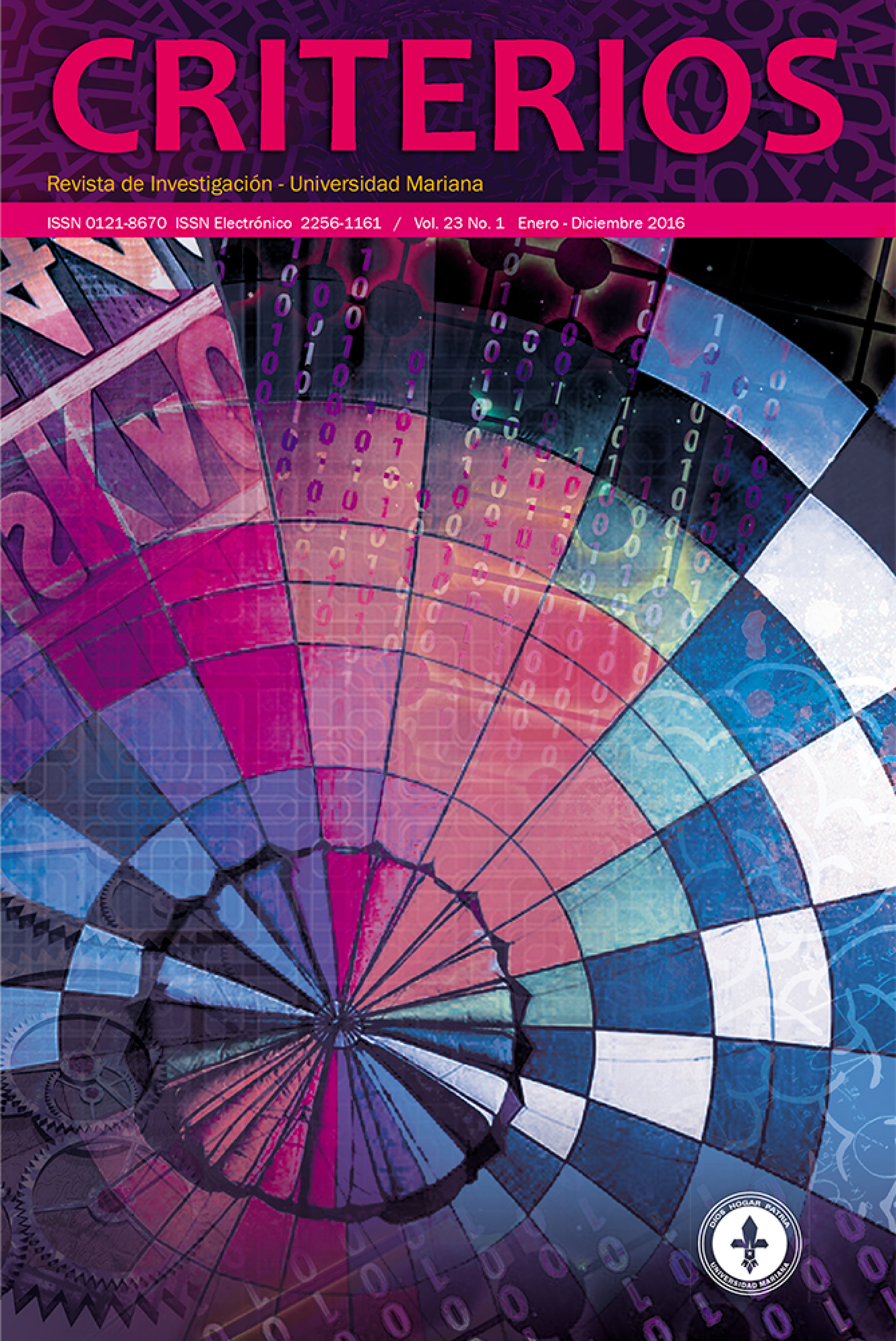Prevalencia de la ciber victimización en estudiantes de la Universidad Pontificia Bolivariana de Bucaramanga
Palabras clave:
ciber victimización, facultad, género, prevalenciaResumen
El fenómeno del cyberbullying en el contexto universitario en Colombia no ha sido muy estudiado en la actualidad, puesto que los principales estudios se han centrado en la población de educación básica primaria y secundaria. Por consiguiente, el objetivo del presente estudio fue analizar y describir la incidencia de la victimización a través de las nuevas tecnologías de la información y la comunicación (Internet y teléfono celular), examinando las posibles diferencias que se pueden presentar respecto al género y a la facultad. La muestra estuvo conformada por 639 estudiantes de la Universidad Pontificia Bolivariana, seccional Bucaramanga (chicos N = 303, chicas N = 334). Los resultados indicaron que el 27.5 % de la muestra ha sido víctima de cyberbullying por lo menos en una ocasión, siendo la duración para la gran mayoría de las víctimas menor o igual a un mes. Además, no se reportaron diferencias estadísticamente significativas respecto al género y a la facultad. Las conclusiones nos llevan a entender que las víctimas de cyberbullying son un grupo bastante frecuente y que requieren de estrategias de intervención especializadas, centradas en diferentes acciones que pudieran ser eficaces como el trabajo con padres, pares ayudantes, líneas tutoriales (por ejemplo, vídeos o juegos interactivos), entre otras.
Biografía del autor/a
Jesús Redondo Pacheco, Universidad Pontificia Bolivariana
Profesor investigador de la Universidad Pontificia Bolivariana, seccional Bucaramanga, Santander, Colombia.
Marianela Luzardo Briceño, Universidad Pontificia Bolivariana
Profesora investigadora de la Universidad Pontificia Bolivariana, seccional Bucaramanga, Santander, Colombia.
Cándido José Inglés Saura, Universidad Miguel Hernández de Elche
Profesor titular de la Universidad Miguel Hernández de Elche, España.
Referencias bibliográficas
Akbulut, Y. & Eristi, B. (2011). Cyberbullying and victimisation among Turkish university students. Australasian Journal of Educational Technology, 27(7), 1155–1170.
Álvarez, D., Núñez, J., Álvarez, L., Dobarro, A., Rodríguez, C. y González, P. (2011). Violencia a través de las tecnologías de la información y la comunicación en estudiantes de secundaria. Anales de Psicología, 27, 221-230.
Buelga, S., Cava, M. y Pons, J. (2009). Cyberbulling: Una nueva forma de maltrato entre los iguales adolescentes. XI Congreso Nacional de Psicología Social. Tarragona: España.
Buelga S., Cava, M. & Musitu, G. (2010). Cyberbullying: victimización entre adolescentes a través del teléfono móvil y de Internet. Psicothema, 22, 784-789.
Beranuy, M. y Sánchez-Carbonell, X. (2007). El móvil en la sociedad de la comunicación. En: A. Talarn (Ed.): Globalización y salud mental (pp. 369-391). Barcelona: Herder.
Beran, T. & Li, Q. (2005). Cyber-harassment: a new method for an old behavior. Journal of Educational Computing Research, 3, 265-277.
Brack, K. & Caltabiano, N. (2014). Cyberbullying and self-esteem in Australian adults. Cyberpsychology: Journal of Psychosocial Research on Cyberspace, 8(2), 1-10. doi: 10.5817/CP2014-2-7
Burgess-Proctor, A., Patchin, J. & Hinduja, S. (2009). Cyberbullying and online harassment: Reconceptualizing the victimization of adolescent girls. En: V. García y J. Clifford (Eds.), Female crime victims: Reality reconsidered (pp. 153-175). Upper Saddle River, NJ: Prentice Hall.
Cabra, F. & Marciales, G. (2012). Comunicación electrónica y ciberbullying: temas emergentes para la investigación e intervención socioeducativa. Psicología desde el Caribe, 29(3), 707-730.
Carrasco, A. y Navas, O. (2013). El acoso a través de las nuevas tecnologías. El cyberbullying. Recuperado de http://www.observatorioperu.com/2014/Setiembre/web-06.pdf
Calvete, E., Orue, I., Estévez, A., Villardón, L. & Padilla, P. (2010). Cyberbullying in adolescents: Modalities and aggressors’ profile. Computers in Human Behavior, 26, 1128-1135.
Caldevilla, D. (2010). Las Redes Sociales. Tipología, uso y consumo de las redes 2.0 en la sociedad digital actual. Documentación de las Ciencias de la Información, 33 45-68.
Camodeca, M. & Goossens, F. (2005). Aggression, social cognitions, anger and sadness in bullies and victims. Journal of Child Psychology and Psychiatry, 46, 186-197.
Campbell, M. (2005). Cyberbullying: An old problem in a new guise? Australian Journal of Guidance and Counselling, 15, 68-76.
Cava, M., Musitu, G. & Murgui, S. (2007). Individual and social risk factors related to overtvictimization in a sample of Spanish adolescents. Psychological Reports, 101, 275-290.
David-Ferdon, C. & Hertz, M. (2007). Electronic media, violence, and adolescents: An emerging public health problem. Journal of Adolescent Health, 41(6), S1–S5.
Defensor del pueblo. (2007). Violencia escolar: el maltrato entre iguales en la Educación Secundaria Obligatoria 1999-2006. Madrid: Oficina del Defensor del Pueblo.
Del Río, J., Bringue, X., Sádaba, C. & González, D. (2010). Cyberbullying: un análisis comparativo en estudiantes de Argentina, Brasil, Chile, Colombia, México, Perú y Venezuela. V Congrés Internacional Comunicació I Realitat. Barcelona.
Dilmaç, B. & Aydoğan, D. (2010). Values as a predictor of cyber-bullying among secondary school students. International Journal of Human and Social Sciences 5, 185-188.
Donegan, R. (2012). Bullying and cyberbullying: History, statistics, law, prevention and analysis. The Elon Journal of Undergraduate Research in Communications, 3(1), 33-42.
Estévez, A., Villardón, L., Calvete, E., Padilla, P. & Orue, I. (2010). Adolescentes víctimas de cyberbullying: prevalencia y características. Behavioral Psychology 18(1), 73-89.
Finn, J. (2004). A survey of online harassment at a university campus. Journal of Interpersonal Violence, 19(4), 468–483.
Finkelhor, D., Mitchell, K. y Wolak, J. (2000). Online victization: a report on the nation ́s youth. Alexandria, VA: National Center for Missing and Exploited Children.
Flisher, A., Evans, J., Muller, M. & Lombard, C. (2004). Brief report: Test–retest reliability of self-reported adolescent risk behaviour. Journal of Adolescence, 27, 207-212. doi: 10.1016/j.adolescence.2001.10.001
Garaigordobil, M. (2011). Prevalencia y consecuencias del cyberbullying: una revisión. International Journal of Psychology and Psychological Therapy, 11(2), 233-254.
García, L., Orellana, O. y Pomalaya, R. (2010). Cyberbullying en escolares de educación secundaria de Lima Metropolitana. Revista de Investigación en Psicología, 13(2), 83-100.
Jang, H., Song, J. & Kim, R. (2014). Does the offline bully-victimization influence cyberbullying behavior among youths? Application of general strain theory. Computers in Human Behavior, 31(1), 85–93.
Jones, J. & Scott, S. (2012). Cyberbullying in the University Classroom: A Multiplicity of Issues. In: L. Wankel & C. Wankel (Eds.), Misbehavior Online in Higher Education. Cutting-edge Technologies in Higher Education, Vol. 5. (pp. 157–182). Bingley, UK: Emerald Group Publishing Limited.
Kapatzia, A. & Syngollitou, E. (2007) Cyberbullying in middle and high schools: prevalence, gender and age differences. Manuscrito no publicado. (Tesis de Doctorado). Universidad de Thessalonika. Grecia.
Kokkinos, C., Antoniadou, N. & Markos, A. (2014). Cyber-bullying: An investigation of the psychological profile of university student participants. Journal of Applied Developmental Psychology, 35, 204–214. doi: 10.1080/02673843.
Kowalski, R. & Limber, S. (2007). Electronic bullying among middle school students. Journal of Adolescent Health, 41, 22-30. doi: 10.1016/j.jadohealth.2007.08.017
Kraft, E. & Wang, J. (2010). An exploratory study of the cyberbullying and cyberstalking experiences and factors related to victimization of students at a public liberal arts college. International Journal of Technoethics, 1(4), 74–91. doi: 10.4018/jte.2010100106.
León del Barco, B., Mira, A., Verdasca, J., Castaño, E. & Gómez, T. (2013). Cyberbullying en Centros de Enseñanza Básica y Secundaria del Alentejo. Temas e Problemas, 12-13, 239-521.
Li, Q. (2006). Cyberbullying in schools: A research of gender differences. School Psychology International, 27, 157-170
Li, Q. (2007). New bottle but old wine: A research of cyberbullying in schools. Computers in Human Behavior, 23(4), 1777-1791.
Lucio-López, L. (2009). Agresores escolares en el ciberespacio; el cyberbullying en preparatorias mexicanas. XI Asamblea general de ALAFEC. Guayaquil. Ecuador. 22-25 septiembre, 1-16.
Mateus, S., Veiga, A., Costa, P. & Das Dores, M. (2015). Cyberbullying: The hidden side of college students. Computers in Human Behavior, 43, 167–182. doi: 10.1016/j.chb.2014.10.045
Monks, C., Smith, P., Naylor, P., Barter, C., Ireland, J. & Coyne, I. (2009). Bullying in different contexts: Commonalities, differences and the role of theory. Aggression and Violent Behavior, 14(2), 1359-1789.
McLoughlin, C., Burgess, J. & Meyricke, R. (2009). Bullies in cyberspace: How rural and regional Australian youth perceive the problem of cyberbullying and its impact. En: T. Lyons y G. McPhan (Eds.) ISFIRE 2009: International symposium for innovation in rural education (pp. 29-30) Armidale, NSW: University of New England.
Noret, N. & Rivers, I. (2006). The prevalence of bullying by text message or email: results of a four year study. Póster presentado a British Psychological Society Annual Conference, Cardiff.
Postigo, S., González, R., Mateu, C., Ferrero, J. y Martorell, C. (2009). Diferencias conductuales según género en convivencia escolar. Psicothema, 21(3), 453-458.
Río, J., Sádaba, C. y Bringué, X. (2010). Menores y redes ¿sociales?: de la amistad al cyberbullying. Revista de Estudios de Juventud, 88, 115-129.
Sabella, R., Patchin, J. & Hinduja, S. (2013). Cyberbullying myths and realities. Computers in Human Behavior, 29(6), 2703–2711.
Sánchez-Carbonell, X. y Beranuy, M. (2007). La adicción a Internet como sobreadaptación social. En: A. Talarn (ed.), Psicopatología en la sociedad global (pp.341-367). Barcelona: Herder.
Sánchez, E. (2007). Las Tecnologías de la Información y la Comunicación (TIC) desde una perspectiva social. Revista Educare, 12(Extraordinario), 155-162.
Schenk, A., Fremouw, W. & Keelan, C. (2013). Characteristics of college cyberbullies. Computers in Human Behavior, 29, 2320–2327. doi: 10.1016/j.chb.2013.05.013
Slonje, R. & Smith, P. (2008). Cyberbullying: Another main type of bullying. Scandinavian Journal of Psychology, 49, 147-154.
Smith, P. (2006). Ciberacoso: naturaleza y extensión de un nuevo tipo de acoso dentro y fuera de la escuela. Paper presentado al Congreso de Educación. Palma de Mallorca, España.
Smith, P., Mahdavi, J., Carvalho, C. & Tippett, N. (2006). An investigation into cyberbullying, its forms, awareness and impact, and the relationship between age and gender in cyberbullying. London: Anti-Bullying Alliance.
Ybarra, M. & Mitchell, K. (2007). Prevalence and frequency of Internet harassment instigation: implications for adolescent health. Journal of Adolescent Health, 41, 189-195.
Ybarra, M. & Mitchell, K. (2008). How risky are social networking sites? A comparison of places online where youth sexual solicitation and harassment occurs. Pediatrics, 121, 350-357.
Walrave, M. & Heirman, W. (2011). Cyberbullying: Predicting victimization and perpetration. Children and Society, 25, 59–72. doi: 10.1111/j.1099-0860.2009.00260.x.
Willard, N. (2006). Cyberbullying and Cyberthreats: Responding to the challenge of online social cruelty, threats and distress. Eugene, Oregon: Center for Safe and Responsible Internet Use.
Willard, N. (2007). The authority and responsibility of school offi cials in responding to cyberbullying. Journal of Adolescent Health, 41(6), S64-S65.
Wright, M. & Li, Y. (2013). Normative beliefs about aggression and cyber aggression among young adults: A longitudinal investigation. Aggressive Behavior, 39, 161–170.
Zacchilli, T. & Valerio, C. (2011). The knowledge and prevalence of cyberbullying in a college sample. Journal of Scientific Psychology, 12-23.
Cómo citar
Descargas
Descargas
Publicado
Número
Sección
Licencia

Esta obra está bajo una licencia internacional Creative Commons Atribución 4.0.
Revista Criterios es publicada por la Editorial UNIMAR de la Universidad Mariana bajo los términos de la licencia Creative Commons Reconocimiento 4.0 Internacional (CC BY 4.0)

Métricas
| Estadísticas de artículo | |
|---|---|
| Vistas de resúmenes | |
| Vistas de PDF | |
| Descargas de PDF | |
| Vistas de HTML | |
| Otras vistas | |








